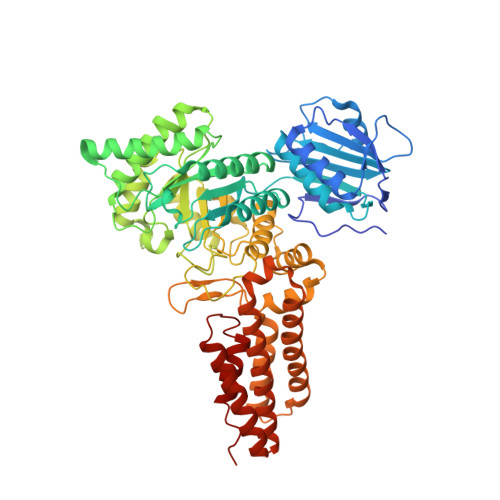GlcNAcstatin: a picomolar, selective O-GlcNAcase inhibitor that modulates intracellular O-glcNAcylation levels.
Dorfmueller, H.C., Borodkin, V.S., Schimpl, M., Shepherd, S.M., Shpiro, N.A., van Aalten, D.M.(2006) J Am Chem Soc 128: 16484-16485
- PubMed: 17177381
- DOI: https://doi.org/10.1021/ja066743n
- Primary Citation of Related Structures:
2J62 - PubMed Abstract:
Many phosphorylation signal transduction pathways in the eukaryotic cell are modulated by posttranslational modification of specific serines/threonines with N-acetylglucosamine (O-GlcNAc). Levels of O-GlcNAc on key proteins regulate biological processes as diverse as the cell cycle, insulin signaling, and protein degradation. The two enzymes involved in this dynamic and abundant modification are the O-GlcNAc transferase and O-GlcNAcase. Structural data have recently revealed that the O-GlcNAcase possesses an active site with significant structural similarity to that of the human lysosomal hexosaminidases HexA/HexB. PUGNAc, an O-GlcNAcase inhibitor widely used to raise levels of O-GlcNAc in human cell lines, also inhibits these hexosaminidases. Here, we have exploited recent structural information of an O-GlcNAcase-PUGNAc complex to design and synthesize a glucoimidazole-based inhibitor, GlcNAcstatin, which is a 5 pM competitive inhibitor of enzymes of the O-GlcNAcase family, shows 100000-fold selectivity over HexA/B, and binds to the O-GlcNAcase active site by mimicking the transition state as revealed by X-ray crystallography. This compound is able to raise O-GlcNAc levels in human HEK 293 and SH-SY5Y neuroblastoma cell lines and thus provides a novel, potent tool for the study of the role of O-GlcNAc in intracellular signal transduction pathways.
- Division of Biological Chemistry & Molecular Microbiology, School of Life Sciences, University of Dundee, Dundee DD1 5EH, Scotland.
Organizational Affiliation:


















